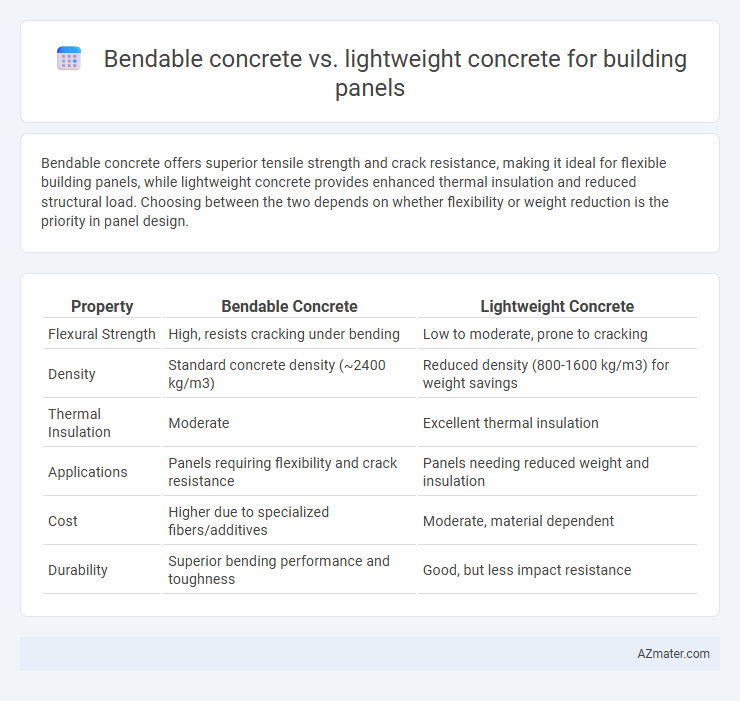Bendable concrete offers superior tensile strength and crack resistance, making it ideal for flexible building panels, while lightweight concrete provides enhanced thermal insulation and reduced structural load. Choosing between the two depends on whether flexibility or weight reduction is the priority in panel design.
Table of Comparison
| Property | Bendable Concrete | Lightweight Concrete |
|---|---|---|
| Flexural Strength | High, resists cracking under bending | Low to moderate, prone to cracking |
| Density | Standard concrete density (~2400 kg/m3) | Reduced density (800-1600 kg/m3) for weight savings |
| Thermal Insulation | Moderate | Excellent thermal insulation |
| Applications | Panels requiring flexibility and crack resistance | Panels needing reduced weight and insulation |
| Cost | Higher due to specialized fibers/additives | Moderate, material dependent |
| Durability | Superior bending performance and toughness | Good, but less impact resistance |
Introduction to Concrete Innovations
Bendable concrete, also known as engineered cementitious composite, offers exceptional tensile strength and flexibility, making it ideal for building panels requiring durability and crack resistance. Lightweight concrete reduces structural load through the incorporation of lightweight aggregates, improving thermal insulation and ease of handling for panel construction. These innovations address specific building panel demands by enhancing performance characteristics beyond traditional concrete mixtures.
What is Bendable Concrete?
Bendable concrete, also known as engineered cementitious composite (ECC), contains fibers that significantly improve its tensile strength and ductility, allowing it to flex without cracking under pressure. Compared to lightweight concrete, which is designed primarily to reduce structural weight by incorporating air or lightweight aggregates, bendable concrete enhances durability and resilience in building panels by absorbing and distributing stresses more effectively. This unique flexibility makes bendable concrete ideal for applications requiring resistance to bending and deformation, improving safety and longevity in construction.
Understanding Lightweight Concrete
Lightweight concrete for building panels is engineered by incorporating lightweight aggregates such as expanded clay, shale, or pumice, resulting in reduced density and improved thermal insulation compared to traditional concrete. Its lower compressive strength relative to bendable concrete makes it ideal for non-structural applications where weight reduction and energy efficiency are priorities. Understanding the balance between lightweight concrete's thermal performance and its mechanical properties is essential for optimizing building panel design in modern construction.
Key Material Properties Comparison
Bendable concrete exhibits high tensile strength and enhanced flexibility due to engineered fiber reinforcements, making it ideal for applications requiring crack resistance and durability under stress. Lightweight concrete offers reduced density and improved thermal insulation, achieved by incorporating lightweight aggregates, which significantly lower dead load but may compromise structural strength compared to bendable concrete. Key material property distinctions include tensile strength values typically exceeding 5 MPa in bendable concrete, whereas lightweight concrete generally has compressive strengths ranging from 8 to 40 MPa and densities between 800 to 1800 kg/m3, emphasizing their differing roles in building panel performance.
Strength and Flexibility Differences
Bendable concrete incorporates engineered fibers to significantly enhance tensile strength and flexibility, allowing building panels to withstand bending and cracking better than standard mixes. Lightweight concrete reduces structural load due to its low density but typically offers lower tensile strength and less flexibility, making it more prone to brittle failure under stress. The choice between bendable and lightweight concrete for building panels depends on the required balance between durability and weight savings in specific construction applications.
Weight and Load-Bearing Capabilities
Bendable concrete offers superior tensile strength and flexibility, allowing building panels to withstand dynamic loads without cracking, while maintaining moderate weight. Lightweight concrete significantly reduces panel weight, enhancing ease of installation and reducing dead load on structures, but typically exhibits lower load-bearing capacity compared to bendable concrete. For high-performance building panels, bendable concrete is preferred when structural resilience is critical, whereas lightweight concrete suits applications prioritizing reduced weight over maximum strength.
Durability and Crack Resistance
Bendable concrete exhibits superior crack resistance compared to lightweight concrete due to its ability to flex without fracturing, making it ideal for building panels exposed to dynamic loads or temperature variations. Lightweight concrete offers reduced structural weight and good thermal insulation but tends to be more brittle, increasing susceptibility to cracking under stress. The enhanced durability of bendable concrete panels extends building lifespan by minimizing maintenance needs caused by crack propagation.
Installation and Application Methods
Bendable concrete panels offer enhanced flexibility during installation, allowing for curved or irregular architectural designs without the need for additional support structures, which reduces labor and material costs. Lightweight concrete panels are easier to handle and transport due to their reduced density, making them ideal for rapid installation in modular construction and prefabricated buildings. Both materials support diverse application methods, with bendable concrete suited for complex forms and lightweight concrete favored in load-sensitive structures requiring quick deployment.
Cost Efficiency and Sustainability
Bendable concrete offers enhanced durability and crack resistance, reducing long-term maintenance costs compared to lightweight concrete used in building panels. Lightweight concrete provides superior thermal insulation and lowers transportation expenses due to its reduced density, contributing to immediate cost savings and energy efficiency. Both materials promote sustainability by minimizing resource consumption, but bendable concrete's extended lifespan often results in greater overall environmental benefits.
Choosing the Right Concrete for Building Panels
Bendable concrete offers exceptional flexibility and crack resistance, making it suitable for building panels that require durability and tensile strength in seismic or high-stress environments. Lightweight concrete provides superior thermal insulation and reduces structural load, ideal for energy-efficient panels and eased handling during installation. Selecting the right concrete depends on application requirements, balancing durability, weight, thermal properties, and cost efficiency for optimized building panel performance.

Infographic: Bendable concrete vs Lightweight concrete for Building panel
 azmater.com
azmater.com